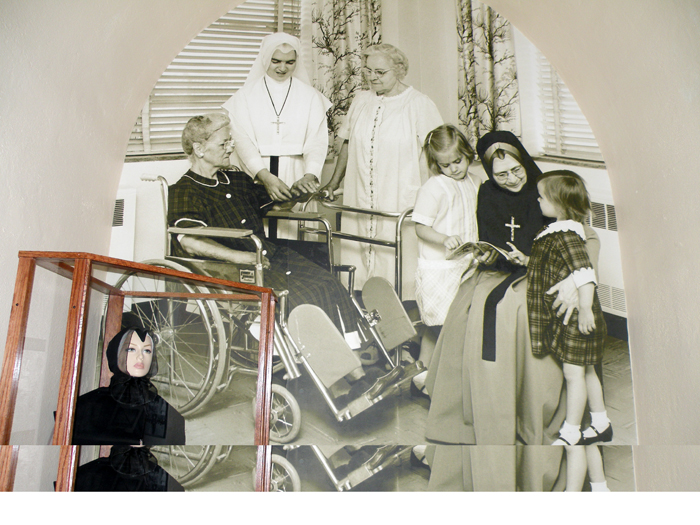A permanent exhibit on the “Grey Nuns,” religious women who came to the Lewiston area from Quebec in 1878 to provide charitable social services, health care and children’s welfare programs, is now on display at the Franco-American Heritage Center on Cedar Street in Lewiston.
The Grey Nuns are the Order of the Sisters of Charity of Montreal, founded by a French-Canadian widow named Marguerite d’Youville (1701-1771). In 1990, d’Youville was canonized a saint in the Roman Catholic Church by Pope John Paul II.
Part of the exhibit is “Les Soeurs Grises: Elles Son Venues-Elles Ont Servi,” an oral history of the Sisters narrated by Mary Rice-DeFosse, a Bates professor of French and bBoard member of the Franco-American Heritage Center.
Two Sisters of Charity, Annette Bourque and Marguerite Stapleton, collaborated with Rice-DeFosse to record oral histories about the nuns work from people who knew and benefited from their social programs.
Les Soeurs arrived in Lewiston at the invitation of Father (Pere) Pierre Hevey. As pastor of Saints Peter and Paul Parish in Lewiston in the 1870s, he invited the first three Grey Nuns to Lewiston to teach at the parish school. He knew them from his hometown of St. Hyacinthe, Quebec.
Although Les Soeurs Grises were primarily known for their work in hospitals caring for the sick, they agreed to be teachers, as Pere Hevey asked. Nonetheless, they made home visits to the sick after their teaching day was over.
“They were amazing women,” said Rice-DeFosse. “They did everything they were asked to do without question.”
They were especially known for including non-religious lay people in their charitable work. Moreover, their social services extended to people throughout the communities, regardless of whether or not they spoke French. “They were non-judgmental to those they cared for,” she says.
As soon as the Grey Nuns arrived by train at Lewiston’s Grand Trunk Station, they began organizing social services for all people who needed their care, in the twin cities of Lewiston and Auburn. In addition to teaching, they founded St. Mary’s General Hospital and Maison Marcotte home for the elderly. They also began two orphanages. The Healy Asylum was for an orphanage boys and Saint Joseph Orphanage was for girls. At that time, orphanages were not necessarily homes for children without parents. Rather, many of the children were from families where both parents worked in the mills.
Rice-DeFosse says the interviews with living residents of the orphanages tell how the Grey Nuns created a family structure for the children. Although they were strict disciplinarians, they were also flexible. They allowed children to participate in activities outside of the orphanage. “Although they were strict, all in all, the sister were sweethearts,” said Rice-DeFosse.
Rita Dube is executive director of the Franco-American Heritage Center. She says the Grey Nuns exhibit is important because the women were the backbone of the social services provided to Lewiston and Auburn during an era when immigrants from French Canada were flooding into the area to find work in local mills. “They made sure people did not fall through the cracks, but got the aid they needed,” she says.
Dube borrowed a habit from the Grey Nuns Mother House in Montreal to use as pattern for the creation of a duplicate garment to display in the Franco Center’s permanent exhibit.
For more information about the Grey Nuns exhibit, direct inquiries to rdube@francoamericanheritage.org.
Copy the Story LinkSend questions/comments to the editors.



Success. Please wait for the page to reload. If the page does not reload within 5 seconds, please refresh the page.
Enter your email and password to access comments.
Hi, to comment on stories you must . This profile is in addition to your subscription and website login.
Already have a commenting profile? .
Invalid username/password.
Please check your email to confirm and complete your registration.
Only subscribers are eligible to post comments. Please subscribe or login first for digital access. Here’s why.
Use the form below to reset your password. When you've submitted your account email, we will send an email with a reset code.